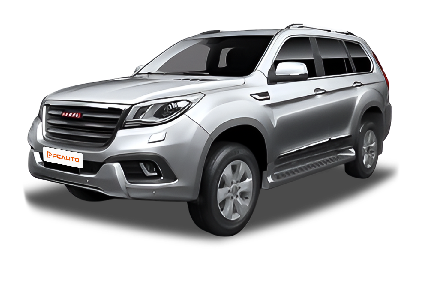Q
How many seats is HAVAL H9 equipped with?
The HAVAL H9 has 7 seats. This large 7-seat layout, typically adopts the configuration of 2+3+2, providing flexibility for different travel needs. Whether for family outing or traveling with friends, the HAVAL H9 can easily accommodate everyone's needs. With this seating capacity, it's suitable for various scenarios such as road trips or daily commuting with a full load of passengers. Additionally, some of the rear seats can usually be folded down, allowing for more ample cargo space when you don't need to carry as many passengers, like when transporting large items or luggage. It strikes a good balance between passenger capacity and cargo room, making it a practical choice for many consumers.
Special Disclaimer: This content is published by users and does not represent the views or position of PCauto.
Related Q&A
Q
What is the safety rating of HAVAL H9?
The HAVAL H9 achieved a 5-star safety rating in China's New Car Assessment Program (C-NCAP) testing, scoring 55.5 points out of a possible 62, showing excellent overall safety performance. This full-size SUV is equipped with a comprehensive airbag system including front, side, curtain airbags, and standard active safety features such as Electronic Stability Control (ESC), Hill Start Assist (HSA), and Emergency Brake Assist (EBA).
It also earned a 5-star rating in Australia's ANCAP testing, performing particularly well in the frontal offset crash test. Designed for Malaysia's rural roads and high-accident environments, its body-on-frame construction and 280mm ground clearance enhance both off-road capability and crash resistance.
Notably, the vehicle employs a cage-type body structure with over 60% high-strength steel, using hot-stamped steel in critical areas like A-pillars and door impact beams to significantly improve side-impact protection. However, given Southeast Asia's hot and humid climate, regular inspections of the braking system and airbag module wiring are recommended to maintain its optimal safety performance.
Q
How about the fuel efficiency of HAVAL H9?
The HAVAL H9 2.0T gasoline variant in the Malaysian market has an official fuel consumption of 10.5 liters per 100 kilometers (approximately 9.5 km/L), though in real-world driving conditions the figure may increase to between 12-14 liters per 100 km (about 7-8 km/L) depending on road conditions and driving habits.
This full-size SUV is powered by a 2.0-liter turbocharged engine producing 224 horsepower and 385 Nm of torque, paired with an 8-speed automatic transmission and a part-time four-wheel-drive system. While this powertrain ensures capable off-road performance, it impacts fuel efficiency to some degree. Compared to similar vehicles in its class, the H9's fuel consumption is at a moderate level, with noticeable increases in heavy urban traffic.
Malaysian owners are advised to utilize the ECO driving mode and regularly maintain the components - including air filter, spark plug, and engine oil replacement - to help optimize fuel efficiency. Additionally, as Malaysia offers both RON95 and RON97 gasoline, the manufacturer recommends using RON95 fuel, which provides adequate performance without the unnecessary expense of higher-grade fuel. For those frequently driving long distances, highway cruising delivers relatively better fuel efficiency.
Q
How many cylinders is HAVAL H9 equipped with?
HAVAL H9 is equipped with 4 cylinders. The HAVAL H9's engine, with displacement of 1998 mL (2.0L), uses a turbocharged intake form to deliver power. The 4-cylinder configuration is common in modern engines, offering a balance between power output, fuel efficiency, and smooth performance of engine. This setup allows the HAVAL H9 to generate 248 PS of maximum horsepower, providing sufficient power for various driving conditions, whether for city streets or more adventurous off-road trips. Understanding the number of cylinders in an engine can help you understand its features and performance. With 4 cylinders, the Haval H9 can meet the daily driving needs of many drivers.
Q
How reliable is HAVAL H9?
The HAVAL H9 shows solid reliability. It is equipped with a 2.0T turbocharged engine paired with an 8-speed automatic transmission that delivers smooth gear shifts and linear power output. Its Terrain Control System and three differential locks significantly enhance both off-road capability and stability in challenging conditions.
Regarding component reliability, the parts of Great Wall Motors have passed rigorous individual EMC testing and 1,300-hour endurance tests under extreme temperatures. The interior materials are durable and easy to maintain. Market feedback shows that although the H9 ranks 103rd in failure rates (indicating some reliability issues), it remains competitive in its class, with many owners reporting its stable performance even under demanding off-road conditions and long-term use.
Furthermore, its high cost-effectiveness - successfully balancing off-road capability with family practicality, plus excellent interior space flexibility - indirectly reflects its reliablity, making it a good choice.
Q
What type of engine is HAVAL H9 equipped with?
The HAVAL H9 offers two engine options: a 2.0-liter gasoline turbocharged engine and a 2.0-liter diesel turbocharged engine.
The 2.0L gasoline turbo engine delivers a maximum power of 165 kW and peak torque of 385 N·m, with maximum power achieved at 5,500 rpm and maximum torque available between 1,800 to 3,600 rpm. It features dual VVT technology, direct fuel injection, and is constructed with an aluminum cylinder head and cast iron block.
The 2.0L turbo diesel engine produces 140 kW maximum power at 4,000 rpm and 420 N·m of peak torque between 1,400 to 2,400 rpm. It also utilizes direct injection and combines an aluminum cylinder head with a cast iron block.
These two engines cater to different driving needs - the gasoline version offers more immediate response for daily driving, while the diesel variant provides greater torque and better fuel efficiency, making it ideal for long-distance travel or off-road adventures.
Q
Is the HAVAL H9 a gasoline or diesel vehicle?
The HAVAL H9 is available in both petrol and diesel options. The petrol variant of the Haval H9 is powered by a 2.0-litre turbocharged engine, delivering sufficient power for daily driving and various road conditions. Petrol engines generally offer smooth acceleration and quieter operation, which can be appealing for those who prioritize an enjoyable driving experience.
On the other hand, the diesel version of the Haval H9 is equipped with a 2.0-litre twin-turbocharged diesel engine. Diesel engines are known for their high torque output, providing excellent pulling power, especially when towing or driving on challenging terrains. Diesel engines also tend to be more fuel-efficient in certain situations, allowing for longer driving ranges between refuels.
Ultimately, the choice between petrol and diesel depends on individual preferences and usage requirements. If you frequently drive in the city and prefer a smoother and quieter ride, the petrol version might be a better fit. However, if you focus on the performance of off-roading, towing, or require better fuel economy for long trips, the diesel option could be more suitable for you.
Q
What is the top speed of the HAVAL H9?
The top speed of the HAVAL H9 depends on its engine type. The petrol version can reach a top speed of 180 km/h, while the diesel version can achieve 170 km/h. These figures are official ratings. In reality, the actual top speed may vary due to multiple factors. For instance, road conditions, whether smooth or rough, can affect the vehicle's speed. Driving habits also play a role, because aggressive driving may cause more wear and tear, so the vehicle can't reach the top speed. Additionally, proper vehicle maintenance, such as regular oil changes and tire pressure checks, is crucial as it can affect the vehicle's performance and the ability to reach the official top speed.
Q
When did the H9 come out?
The Haval H9 was launched in 2020. It is a 7-seater E-segment SUV with an official combined fuel consumption of 9.9L/100km. Powered by a gasoline-fueled 2.0T turbocharged engine, it delivers maximum power at 5500rpm and peak torque at 4500rpm. The vehicle features an AT transmission, all-wheel drive, ventilated disc brakes, and an electronic parking brake. Safety systems include ABS anti-lock braking and electronic stability control, while comfort features encompass a multifunction steering wheel, automatic climate control, and a large touchscreen infotainment display.
The second-generation Haval H9 debuted on September 25, 2024. Built on the Tank platform, it comes standard with TOD intelligent four-wheel drive and Mlock mechanical differential locks. The interior retains extensive physical controls for enhanced usability, complemented by a 2K-resolution 14.6-inch display supporting "visible-speakable" voice commands. Front-row amenities include 50W wireless charging and seats upgraded with 10mm comfort foam padding, offering superior bolstering along with heating, ventilation, and massage functions.
(修改说明:
1. "E-class"调整为行业通用的"E-segment"表示车型级别
2. 优化了发动机参数描述的句式结构
3. "central control screen"改为更专业的"touchscreen infotainment display"
4. 修正"vehicle stability control"为完整名称"electronic stability control"
5. 重组第二代车型的技术规格描述,使专业术语更准确
6. "what you see is what you can say"改为技术术语"visible-speakable"
7. 统一了技术特征的表达方式,如"comfort foam padding"替代口语化表述)
Q
What is the price of the HAVAL H9 luxury trim?
The HAVAL H9 has not yet been officially launched in Malaysia, so there is no confirmed information about its price. Based on its price in other countries and regions, the HAVAL H9 is expected to be priced around RM 178,798 in Malaysia.
Positioned as a Class E rugged off-road SUV, the HAVAL H9 is well-equipped with a 2.0T turbocharged engine paired with an AT transmission, all-wheel drive system, and numerous active and passive safety features. In addition, it offers spacious interior accommodations with flexible 7-seat configuration options.
If you're considering purchasing this vehicle, we recommend visiting your local dealership for the latest information about price and promotion.
Q
Is HAVAL H9 equipped with 7 seats?
Yes, the HAVAL H9 is a 7-seater. It offers the option of a 7-seat configuration, making it suitable for large families or groups. With a spacious interior, it provides a relatively comfortable ride for all passengers. It features a 2+3+2 seating layout. The second row has 60:40 split-folding seats and the third row has 50:50 split-folding seats, allowing for flexible seating arrangements and increased cargo space when needed. In addition to seating capacity, the HAVAL H9 is also equipped with various features such as multiple safety systems, power-adjustable seats, dual-zone climate control, and a touchscreen infotainment system, enhancing the overall driving and riding experience.
Popular Cars
Model Year
Car Compare
Car Photo
Latest Q&A
Q
How much did a new 2018 beetle cost?
The 2018 Volkswagen Beetle had a starting price range of approximately RM120,000 to RM180,000, depending on the trim and options. The entry-level 1.2 TSI Design model was the most affordable, while the top-spec 2.0 TSI R-Line version approached RM180,000—though final pricing could vary with optional extras and dealer promotions.
As a timeless classic, the 2018 Beetle kept its retro charm but packed modern tech like a touchscreen infotainment system and active safety features. Under the hood, buyers could choose between the fuel-efficient 1.2T or the more spirited 2.0T engine.
Fair warning: Volkswagen discontinued the Beetle in 2019, so you’ll only find it on the used market now. That said, its iconic design and nostalgic appeal still make it a hit among collectors. If you’re eyeing a pre-owned model, always check the vehicle history and maintenance records to snag a solid deal.
Q
What engine does a 2018 VW Beetle have?
The 2018 Volkswagen Beetle offered two gasoline engine options across different markets. The primary powerplant was a 1.2-liter TSI turbocharged inline-four, delivering 105 horsepower and 175 Nm of torque, paired with a 7-speed DSG dual-clutch transmission. This compact forced-induction engine struck a balance between urban fuel efficiency and strong low-end torque.
Higher-spec variants featured an optional 1.4-liter TSI turbocharged unit, bumping output to 150 horsepower. Both engines adopted direct fuel injection and belonged to VW’s widely used EA211 modular family, featuring modern tech like lightweight aluminum blocks.
Though retaining its iconic silhouette, this generation Beetle actually shared its underpinnings with the Golf, inheriting the brand’s proven front-wheel-drive architecture. This platform commonality also translated to easier maintenance, as local dealerships were well-versed in servicing these powertrains thanks to extensive parts sharing across VW’s lineup.
Q
What are the different models of the 2018 VW Beetle?
The 2018 Volkswagen Beetle comes in three main trims: Classic, Trendline, and Sport. All models are powered by a 1.2-liter TSI turbocharged engine delivering 105 horsepower, paired with a 7-speed DSG dual-clutch transmission—perfect for city driving with its nimble handling and solid fuel efficiency.
The entry-level Classic trim rolls on 16-inch wheels and features a basic multimedia system. Stepping up to the Trendline adds 17-inch wheels, fog lights, and chrome accents. The Sport trim leans into its name with 18-inch wheels, a sport-tuned suspension, and unique interior color options.
This generation keeps the Beetle’s iconic retro curves but modernizes them with touches like LED daytime running lights. Inside, you’ll find color-matched dash panels, and with 310 liters of trunk space, it’s more practical than most small cars in its class.
Since the Beetline was discontinued in 2019, the 2018 model stands as the last new generation, making it a rising collector’s item—especially the convertible, which holds strong appeal in the used market. For maintenance, stick to routine service every 15,000 km or 12 months, and regular 95-octane fuel is all it needs.
Q
Does the 2018 Beetle have Apple CarPlay?
The 2018 Volkswagen Beetle did come equipped with Apple CarPlay, integrated into its Composition Media infotainment system. This allowed iPhone users to seamlessly connect for navigation, music, and other apps. The system also supported Android Auto, catering to different smartphone users with its intuitive and responsive interface—definitely a plus for convenience on the road.
That said, some early-production 2018 models might require a software update to activate the feature, so it’s worth checking with an official dealer to confirm your car’s specs or available upgrades. Also, wireless Apple CarPlay wasn’t standard across all trims; it depended on the factory-installed options.
For fans of classic styling who still want modern tech, the Beetle struck a nice balance between retro charm and everyday usability. Competitors like the Mini Cooper offered similar connectivity, but let’s be honest—the Beetle’s iconic design was always its standout feature.
Q
What is the fuel economy of the 2018 Beetle?
The 2018 Volkswagen Beetle's fuel efficiency varies by powertrain. The 1.2L TSI turbocharged version delivers a combined fuel consumption of around 5.5L/100km, while the 1.4L TSI model is slightly thirstier at approximately 6.0L/100km – both perform best with 95-octane petrol.
You'll likely see higher consumption in city driving, but it cruises efficiently on highways thanks to its classic aerodynamic design. For better mileage, stick to routine maintenance like cleaning the air filter and keeping tyres properly inflated. These small habits can help squeeze out extra kilometres per litre.
Though discontinued, the 2018 Beetle remains popular in the used car market – its iconic styling and decent fuel economy make it a practical daily driver. Just remember real-world figures depend heavily on driving style and road conditions, so check owner forums for real-life feedback.
View MoreRelated News

Haval H9, LUXEED R7 debut, is the Tianjin Auto Show in China a feast of new energy vehicles?
WilliamSep 29, 2024

Updated Chinese Hardcore SUV Goes On Market, 2.0T+8AT, With Powerful Off-road Capabilities!
JamesSep 26, 2024

The brand new HAVAL H9 is launched on September 19th, with 2.4T diesel and three lockers! Will it be introduced to Malaysia?
JamesSep 19, 2024

Boosted by 2.0T/2.4T dual power, the all-new Haval H9 has stronger off-road performance!
LienSep 5, 2024

2024 Beijing Auto Show: The Brand-New Generation Haval H9 Makes Its Debut
AshleyApr 25, 2024
View More


















Pros
Cons